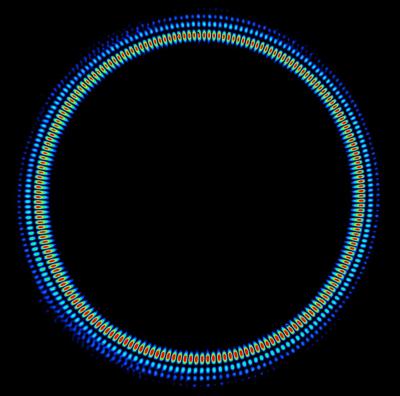Nov 3 2012
To this end, the researchers developed a new method for entangling single photons which gyrate in opposite directions. This result is a first step towards entangling and twisting even macroscopic, spatially separated objects in two different directions.
 False-color image of a laser beam exhibiting a superposition of 100 right-handed and 100 left-handed quanta of orbital angular momenta, resulting in 100+100=200 bright spots on the inner ring. Credit: Robert Fickler, University of Vienna
False-color image of a laser beam exhibiting a superposition of 100 right-handed and 100 left-handed quanta of orbital angular momenta, resulting in 100+100=200 bright spots on the inner ring. Credit: Robert Fickler, University of Vienna
The researchers at the Vienna Center for Quantum Science and Technology (VCQ), situated at the University of Vienna, and the Institute for Quantum Optics and Quantum Information (IQOQI) at the Austrian Academy of Sciences have were able to get their pioneering results published in the current issue of the renowned scientific journal Science.
Quantum physics is usually considered to be the theory of extremely lightweight objects, such as atoms or photons, or of exceptionally small units, namely very small quantum numbers. One of the most fascinating phenomena of quantum physics is that of entanglement. Entangled quanta of light behave as if able to influence each other – even as they are spatially separated. The question of whether or not entanglement is limited to tiny objects or very small quantum numbers came up already in the early days of quantum physics. Now, the Vienna group has taken the first step for testing quantum mechanical entanglement with rotating photons. To illustrate, a quantum mechanical figure skater would have the uncanny ability to pirouette both clockwise and counter-clockwise simultaneously. Moreover, the direction of her rotations would be correlated with the twirls of another, entangled, skater – even if the two ice dancers whirl far removed from each other, in ice rinks on different continents. The faster the two quantum skaters pirouette, the larger is the quantum number of their rotation direction, the so-called angular momentum. "In our experiment, we entangled the largest quantum numbers of any kind of particle ever measured," declares Zeilinger with a wry smile.
Could quantum ice dancers exist in reality?
It has been common knowledge for about 20 years now that theoretically, there is no upper limit for the angular momentum of photons. Previous experiments, however, have been limited, due to physical restrictions, to very weak angular momentum and small quantum numbers. In the Vienna experiment, it is theoretically possible to create entanglement regardless of the strength of the angular momentum or the scale of its quantum number. "Only our limited technical means stop us from creating entanglement with twisted photons that could be sensed even with bare hands," states Robert Fickler, the main author of the current Science publication. And so, the researchers have demonstrated that it is possible in principle to twirl entangled ice skaters simultaneously both in clockwise and counter-clockwise directions. In practice, a number of major challenges need to be addressed before such an experiment can be realized with macroscopic objects.
From fundamental research to technical applications
In addition to the fundamental issue of the limits of macroscopic entanglement, the physicists address possibilities of potential applications. They are, for example, able to use the created photons for very precise angular measurements already at low intensities of light. This feature is of advantage in particular when investigating light sensitive materials, as for example some biological substances. "The special features of entanglement provide the fantastic possibility to perform such measurements from arbitrary distances and without any contact whatsoever with the measured object, or even at a point in time that lies in the future!" Fickler explains.